Driving business success isn’t as simple as knowing your customer anymore. As the Ancient Greeks told us, you’ve also got to “Know Thyself.”
If you want to develop a business strategy that outperforms the competition, that means getting laser-focused on the things that you do better than anyone else and bolstering any gaps in your business arsenal.
Using a SWOT analysis allows you to deep dive into your internal capabilities, so you can understand how to maximize them to exploit opportunities and mitigate risks to your business.
In this article, we’ll explain what a SWOT analysis is and when you should use one. We’ll highlight the benefits and limitations of this analysis type and share seven simple steps to get you started.
Try Miro’s Swot Analysis Template
What is a SWOT analysis?
SWOT is an acronym that stands for Strengths, Weaknesses, Opportunities, and Threats.
A SWOT analysis is the process of evaluating the capabilities of your business and identifying its unique strengths and weaknesses.
Based on what you know about the market and your competitors, you can use this information to identify potential opportunities and threats and feed this into your strategic planning.
Strengths and weaknesses are internal factors that affect how well your business can exploit potential opportunities and mitigate potential threats.
For example, say you’ve used a PEST analysis to understand your external macro-environment better. That analysis flagged a change in government policy that resulted in the deregulation of your target market.
These changing circumstances could offer significant company growth if you’re able to bring your product to a new market. However, that only becomes a realistic opportunity if your company has the skills, infrastructure, and budget to exploit it.
Performing a SWOT analysis helps you understand if this opportunity is realistic for you.
At an organizational level, the marketing department is often in charge of completing the SWOT analysis, and then they present the results to senior management to inform their decision-making.
Businesses can also use the SWOT framework to inform departmental planning and help managers determine how to use budgets and resources most effectively.
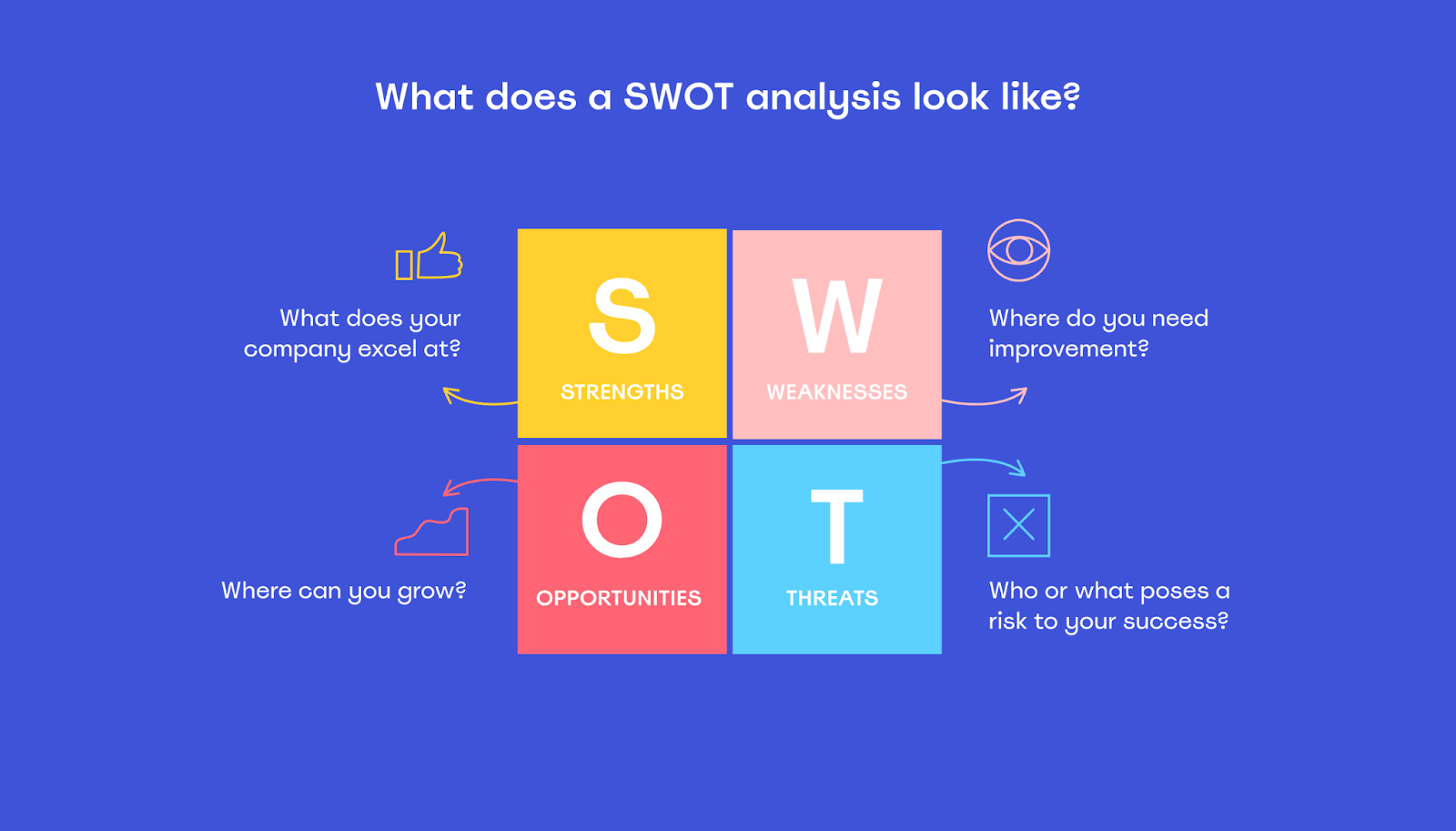
What are the four parts of a SWOT analysis?
Now that you’re clear on what SWOT stands for, let’s look at the four individual parts in more detail.
Strengths
Your company’s strengths are internal factors that you do well and that separate you from your competition. They are things within your control that enable you to create and sustain success.
Your organization’s strengths may include your unique product, specific professional expertise, innovative company culture, or popular brand image.
To help you identify your strengths, consider the following questions:
- What things does our company do well?
- What internal resources do we have that create value?
- What tangible assets do we own?
- What unique qualities set us apart from our competitors?
Weaknesses
Weaknesses are areas of your business that may stop you from exploiting opportunities and leave you more vulnerable to threats. They’re areas that your business performs less well at compared to its competitors.
Like strengths, they’re internal factors that are within your control, so you can improve them with the right approach and resources.
Examples of weaknesses could include unreliable cash flow, employees with a limited skillset, inefficient processes, or poor brand reputation.
It’s important to be reflective when considering your weaknesses. Self-awareness and honesty enable you to accurately identify areas of weakness, which is the first step toward correcting them.
To help discover your weaknesses, try asking:
- Where do we have fewer resources than our competitors?
- What things do our competitors do better than us?
- What operational processes do we need to improve?
Opportunities
Now it’s time to look at the aspects you can use to gain a competitive advantage over your competition: opportunities.
Opportunities arise within your industry environment and allow you to become more profitable, and you should grasp them when they arrive.
Opportunities are external factors, which means they’re uncontrollable and unchangeable. They may present themselves through a change in regulations, the availability of new technologies, competitors going out of business, or market trends.
To help identify opportunities, consider these questions:
- What market opportunities are present?
- What trends can we take advantage of?
- What’s the best way to leverage our strengths?
Threats
Threats are also uncontrollable external factors and include anything that can negatively affect your business.
It’s essential to forecast potential threats in order to anticipate the impact and create a contingency plan.
Macro-environmental factors such as changes in government policy, deregulation of markets, and the availability of new tech may be either an opportunity or threat, depending on how well your capabilities stack up against your competitors.
To help identify threats, ask these questions:
- What macro-environmental factors may negatively affect our business?
- How do our weaknesses expose us to threats?
- What is our competition doing that could harm our business?
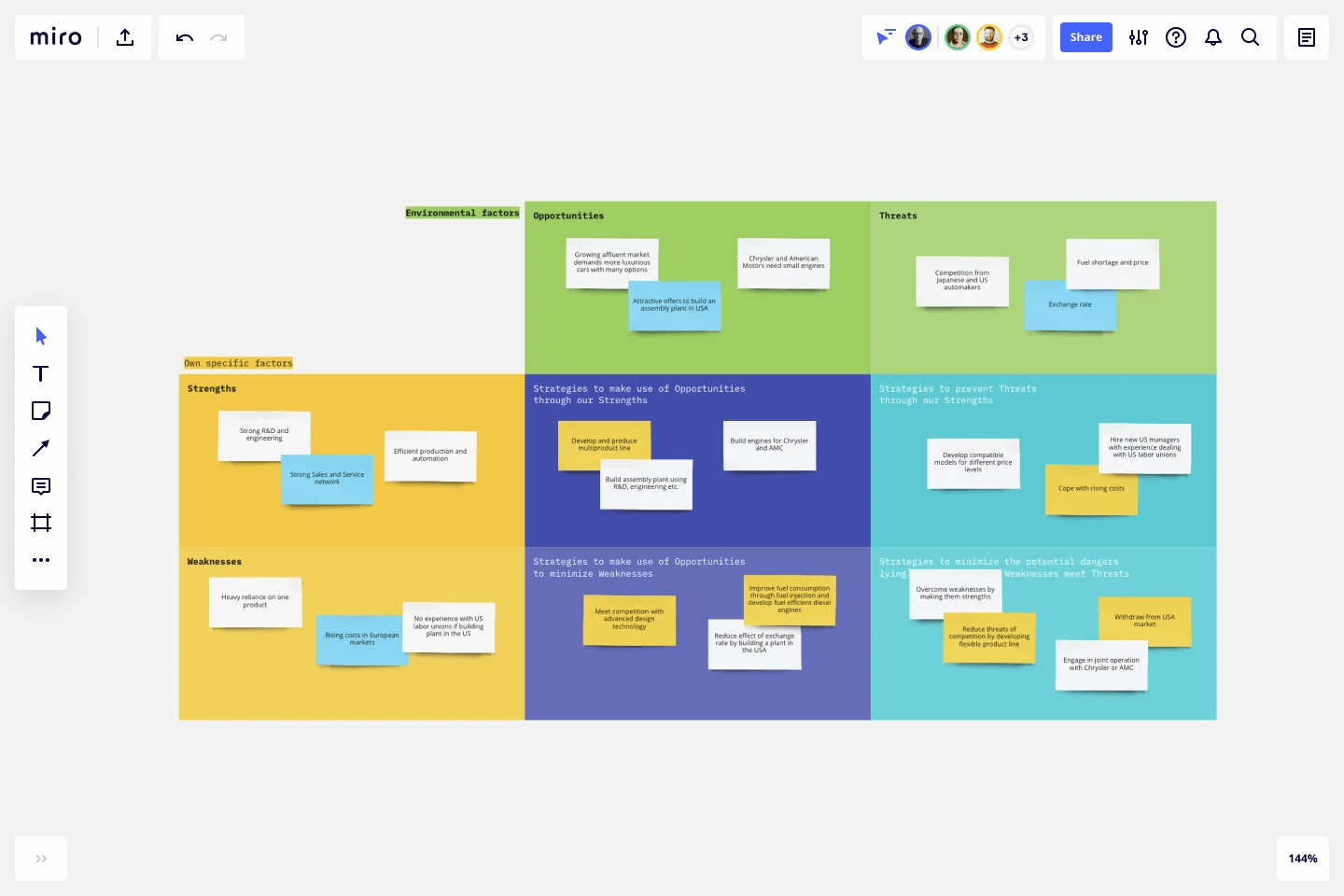
What is SWOT analysis in marketing?
The marketing function is often responsible for compiling data to use in a SWOT analysis. That’s because marketing is uniquely placed to analyze the external environment, market and consumer trends, and competitor activity.
Marketing can also use a SWOT analysis to help position your organization in order to create a competitive advantage and make you stand out from competitors.
Its goal would be to determine whether a project, campaign, or entire marketing approach is likely to be successful based on what’s known about the external market and internal capabilities.
By applying the SWOT framework, marketers can determine the most effective use of the marketing mix to leverage company strengths.
Your company’s strengths create its competitive advantage and allow marketers to optimize how you position your goods or services in the market to satisfy your customers’ needs.
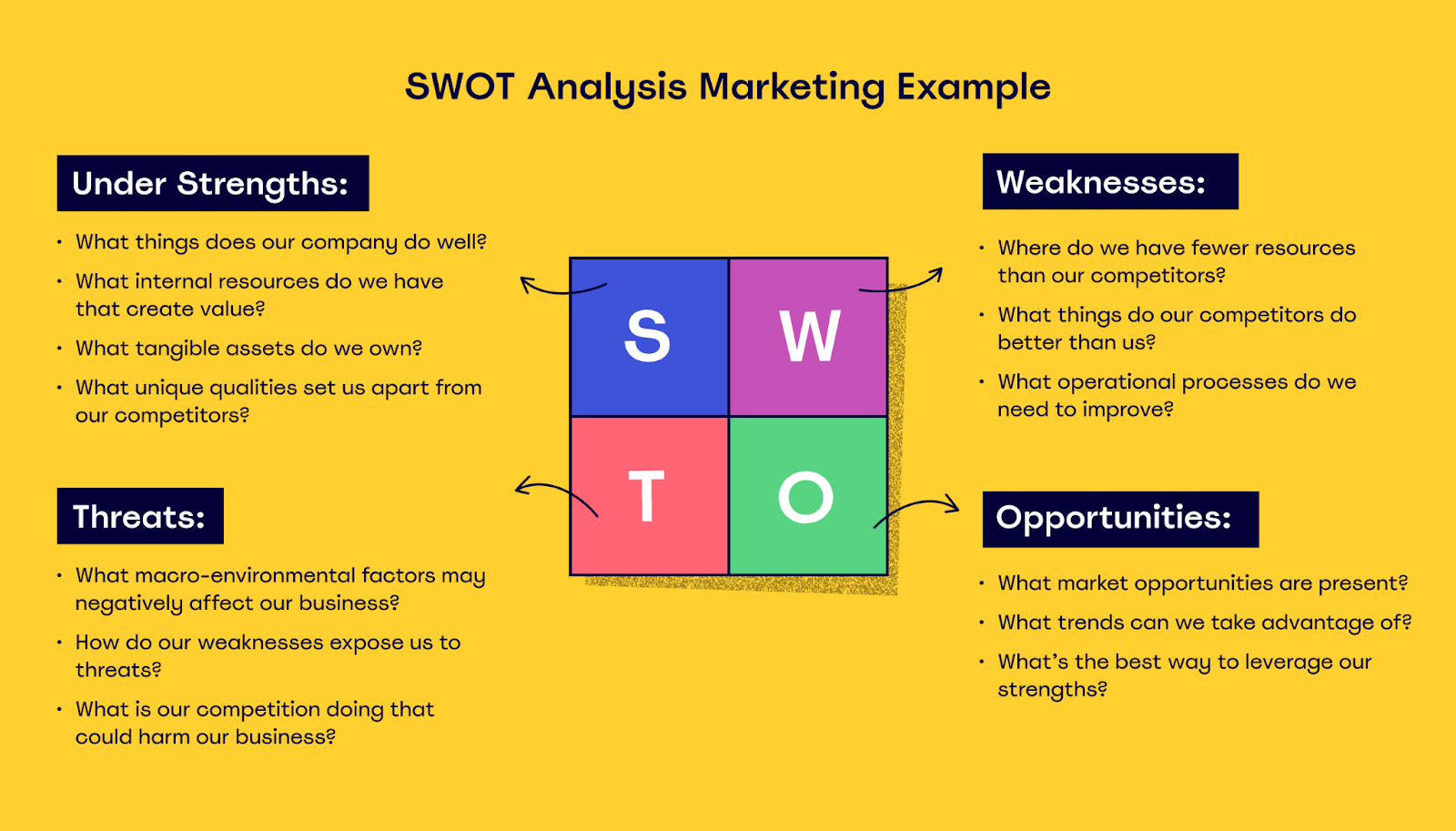
Benefits and limitations of performing a SWOT analysis
A SWOT analysis is a powerful tool to determine the relative position of your business within the market. While using the framework can prove beneficial, there are also limitations you should be aware of. We’ll look at both benefits and limitations in this section.
SWOT analysis benefits
First, let’s consider how a SWOT analysis can be of help to organizations.
1. Provides a stake in the ground
A SWOT analysis provides the perfect opportunity for you to stop and reflect on your current position. It enables business stakeholders to come together and brainstorm on business capabilities and consider what the next steps should be for the organization.
Completing the analysis process requires seeking a viewpoint from several functional areas, which may, in turn, prompt greater collaboration and improved, shared viability of the future approach.
2. Improves your understanding of the environment
Unsurprisingly, the SWOT analysis process helps you get a clearer picture, not only of your business but also of the broader market, your competitors, and your customers.
Without this clarity, decisions about your future strategy rely on luck rather than judgment.
3. Enables anticipation of opportunities and threats
A robust SWOT analysis enables you to forecast potential opportunities and threats before they arise. Coupled with the knowledge gained about your strengths and weaknesses, this means you can act quickly to match your capabilities to opportunities.
This is important so that you can maximize your resources and not seek to exploit opportunities you don’t have the internal capabilities for.
It also means you can anticipate threats in advance and create a mitigation strategy to reduce their negative impact on your business.
4. Improves decision-making
A well-executed SWOT analysis allows you to rely on facts, not assumptions. This means you can make decisions with up-to-date and accurate information at your fingertips.
After completing your analysis, you’ll know what you’re good at, which opportunities to grasp, where you need to improve, and which threats you need to avoid.
This helps you get really clear on your next steps, whether that’s bolstering your strengths, developing strategies to reduce your weaker areas, or pursuing opportunities.
SWOT analysis limitations
Now that you’re clear on the benefits of the SWOT analysis, let’s take a quick look at its limitations.
1. Lacks objectivity
Whenever you conduct an internal analysis, you see every aspect through the lens of your company.
So whatever bias your team has toward your strengths, weaknesses, opportunities, and threats shows in the data.
Engaging multiple stakeholders helps overcome personal perceptions, and getting an external perspective from a third party can help overcome biases — this can include customer feedback.
If that’s not possible, it’s essential to ask the question, “What would our competitors/customers say about our strengths or weaknesses?”
2. Causes information overload
Once you start brainstorming, you may find that you identify several aspects that are relevant to your business and your industry environment.
This might include information at both a macro and micro level, and it can get overwhelming as you start getting into the details, as each thing identified could prompt you to think of something else.
3. Identifies problems, not solutions
Conducting a SWOT analysis means identifying the things that you’re not great at or may cause you problems in the future.
While this is absolutely necessary so that you can take steps to make improvements, it can be a bit disheartening.
A SWOT analysis also doesn’t offer solutions to any of these challenges, which is why it’s critical that it’s not just a paper exercise — you use it to inform action.
4. Lacks prioritization
There are no prioritization criteria within the framework that help businesses identify their most pressing issues. You just collect everything within a single list.
In order to gain clarity about which opportunities or threats need to be acted upon first, it’s useful for managers to create a way to prioritize items. This might involve assessing them against criteria such as the likelihood of occurrence and level of impact should they occur.
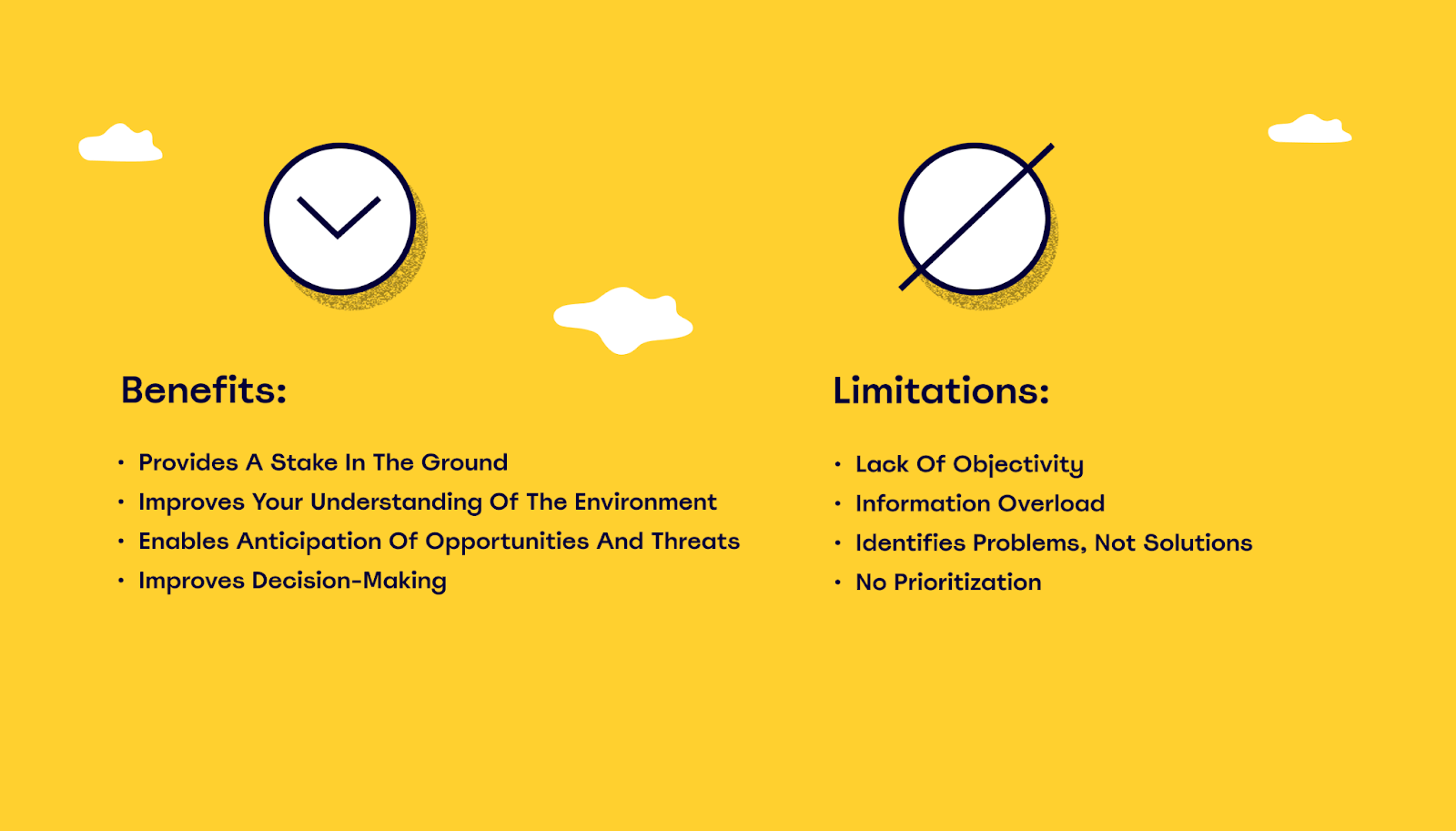
When should you use a SWOT analysis?
So now you’re clear on what the purpose of a SWOT analysis is, but how exactly do you know when to perform one?
Well, there are no precise criteria for when you should do a SWOT analysis.
You can do one every quarter, every year, or even every few years. It comes down to how often you want to review the position you occupy in the industry.
Some markets are particularly volatile and may require more frequent analyses to help you stay up to date. Others are more stable.
SWOT is an important tool to support senior management’s effective decision-making. The more information they have, the easier it gets to pinpoint the direction with the highest chance of success.
This means whenever the business is considering changing strategy or determining the viability of a critical project, a SWOT analysis is a smart choice.
You’ll want to analyze your planned approach within the context of the current market and your capabilities before deciding if it’s the right move.
With a SWOT analysis, you identify exactly where you are right now and what you need to do to get to where you want to be. This allows for tailored strategies that focus on your strengths, improve your weaknesses, and allow the business to exploit future opportunities.
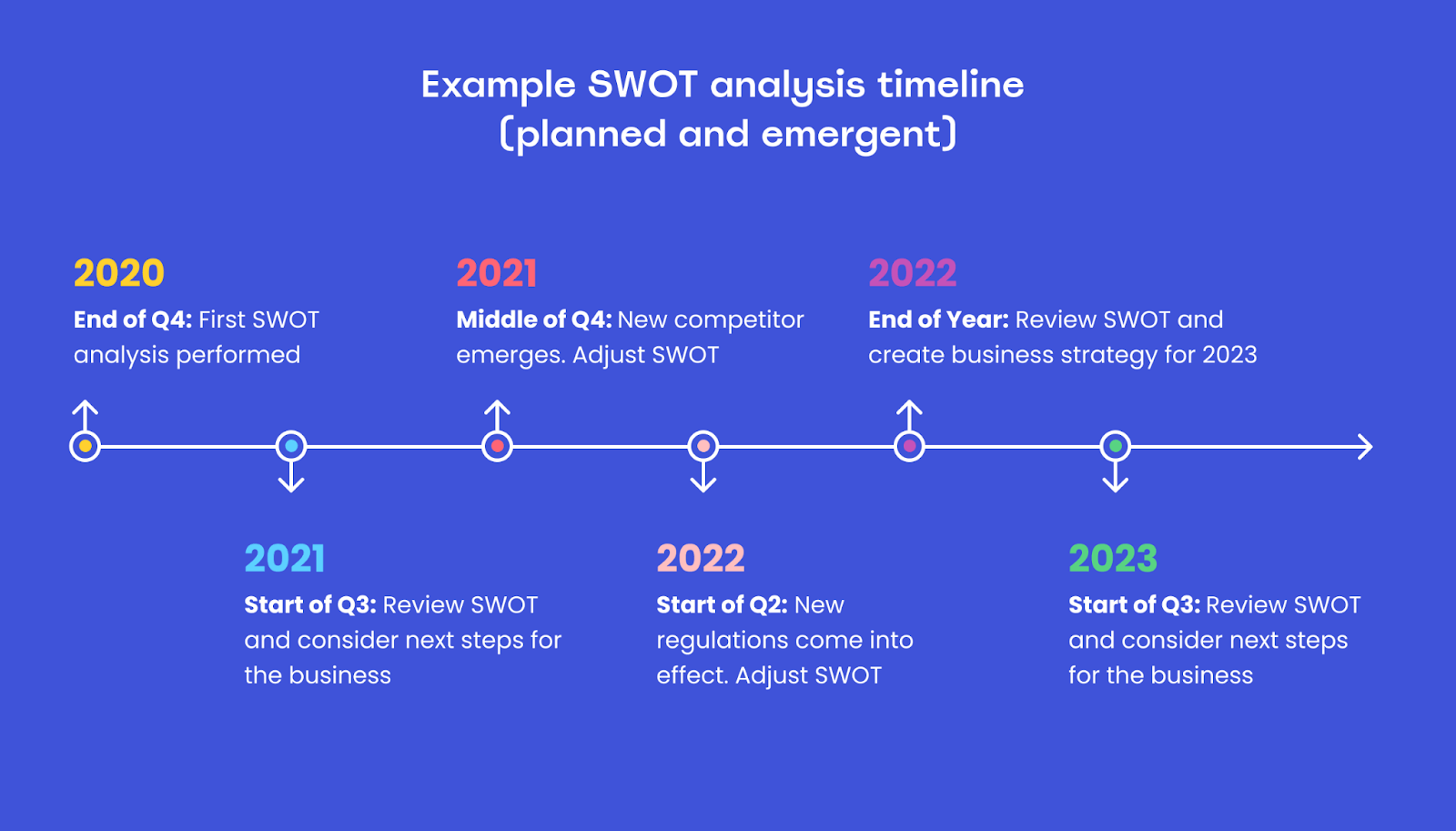
How to do a SWOT analysis in 7 easy steps
A SWOT analysis is relatively straightforward to conduct. The effort comes in collecting the correct data to inform the process rather than the process itself.
Let’s look at seven simple steps to perform an effective SWOT analysis:
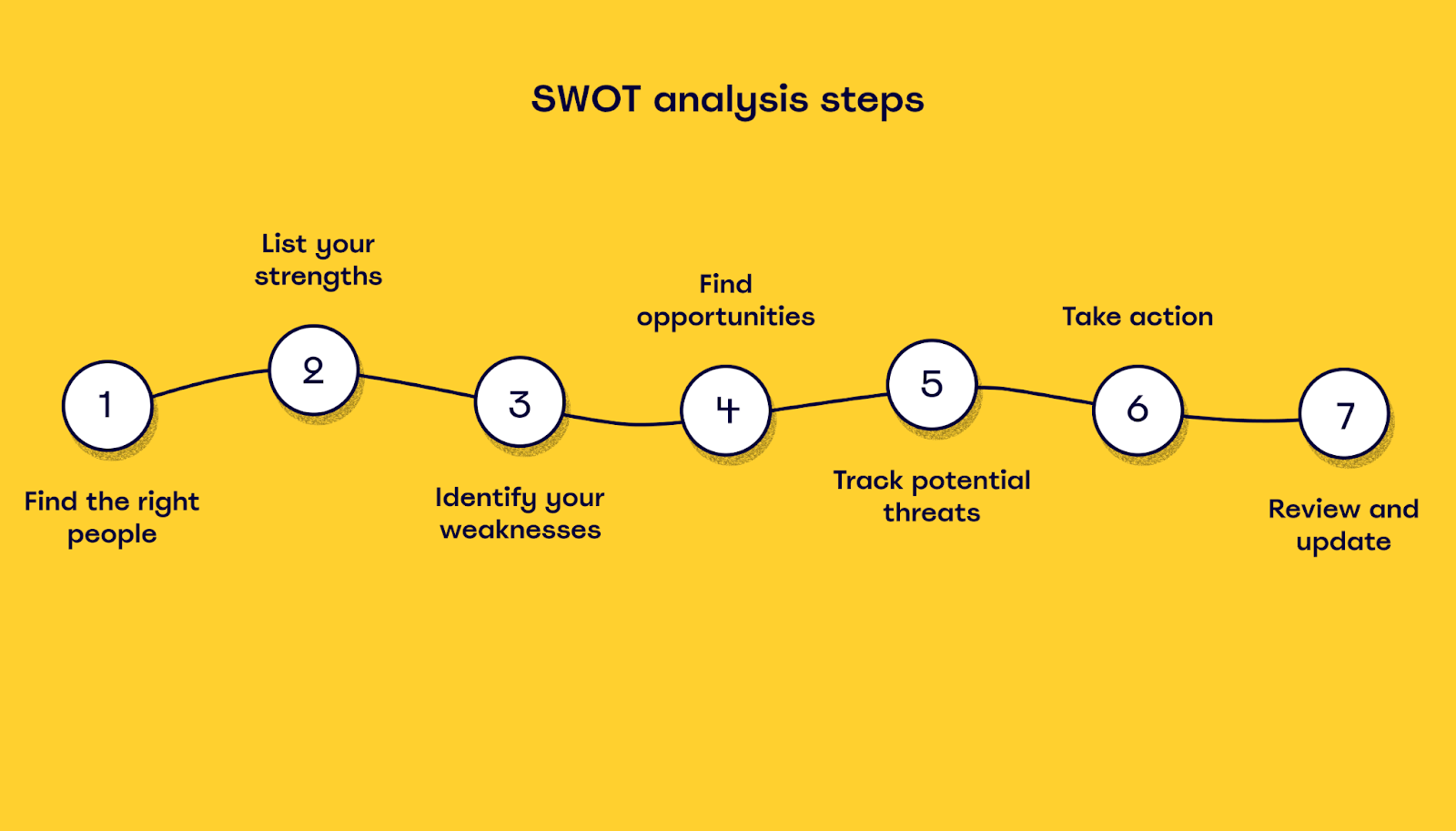
Step 1: Find the right people
Before you start gathering data, make sure you’ve got the right people involved. While company leaders need to be present, you should also ask selected team members from across the business to contribute.
The reason is that every person and department has a different view of all four pillars of the SWOT analysis.
To make your research as effective as possible, invite everyone to your single shared Miro board. This makes for easy brainstorming with your team, remotely or in-person.
To start capturing information, set up our SWOT analysis template and begin jotting down ideas.
Step 2: List your strengths
First, note down all the strengths your business or project has.
These can be tangible things, such as significant cash reserves, as well as intangible aspects, such as a recognizable brand logo.
If you get stuck, consider the questions outlined above to get moving again.
Step 3: Identify your weaknesses
This third step focuses on your company’s weaknesses and the aspects of your business you need to improve. Create this list under the “Weaknesses” quadrant of your framework, and try to be honest with yourself.
While it can seem a bit brutal to call out areas where you’re underperforming, it’s essential. After all, you can only fix what you can see and understand.
Step 4: Find opportunities
Next, take a deep dive into your potential opportunities.
If you’ve performed a PEST analysis that examines your macro-environment, start there. Otherwise, think creatively about external factors that can propel your business forward and increase profits.
You may identify opportunities by considering how you can further exploit your strengths or by examining your competitors’ weaknesses and seeing where you can drive home an advantage.
Or you may look at how the external market is changing and what opportunities that may create.
Haven’t done a PEST analysis yet? You can quickly complete one with our editable PEST analysis template.
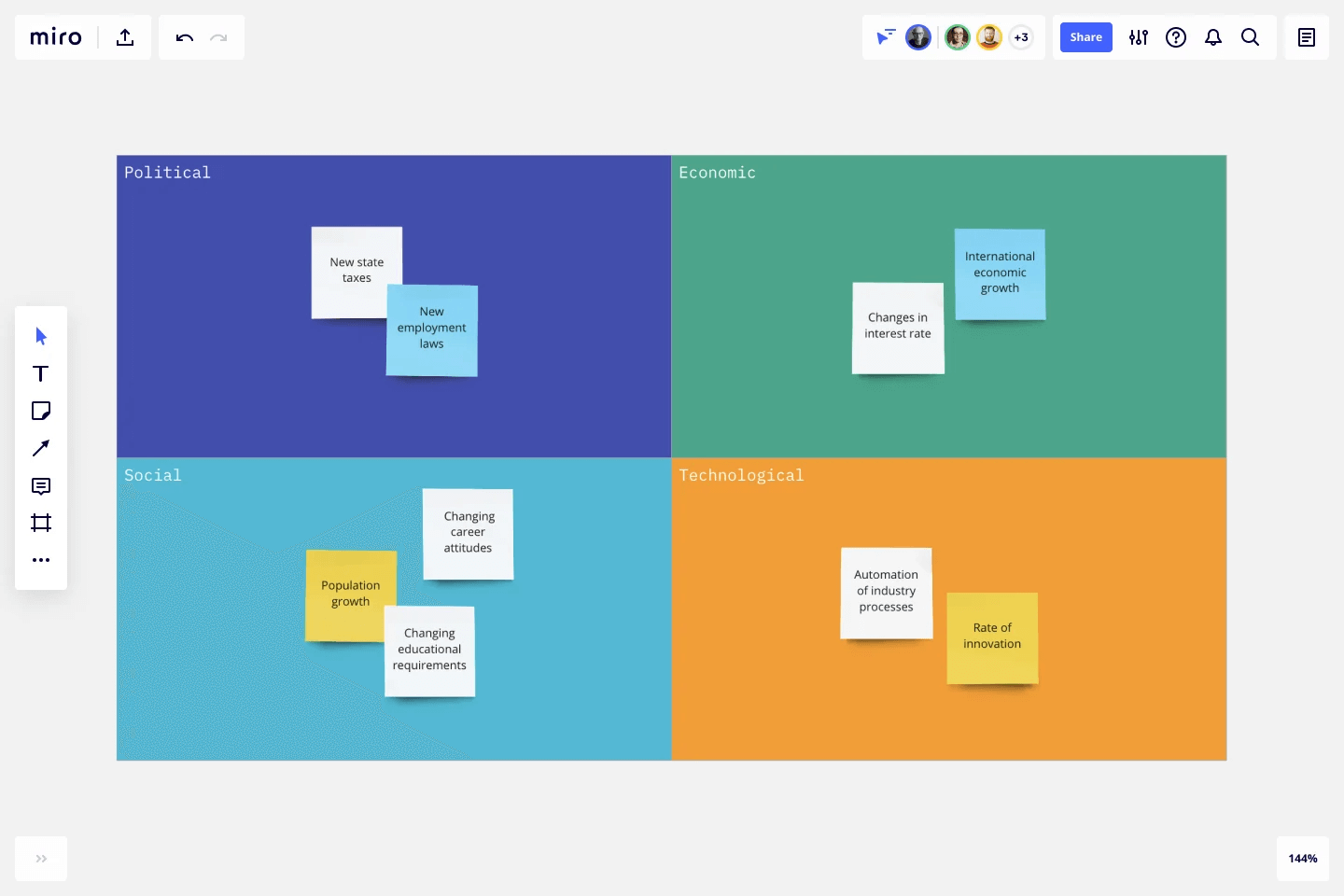
Step 5: Track potential threats
Now it’s time to gather data for the last quadrant.
Begin to note down threats that may harm the success of your business. You can either come up with threats that derive from your weaknesses or threats related to your competition and external environment.
Step 6: Take action
After you’ve captured all your data in the SWOT diagram, you need to decide what action to take. Begin by prioritizing the most pressing issues.
You might do this by considering how likely an opportunity or threat is to occur and the impact it would have if it happened. Some opportunities or threats may also be time-bound and need more urgent action to ensure success.
When you use the SWOT template, set up a voting system to make it simple for stakeholders to choose which issues they think should be tackled first.
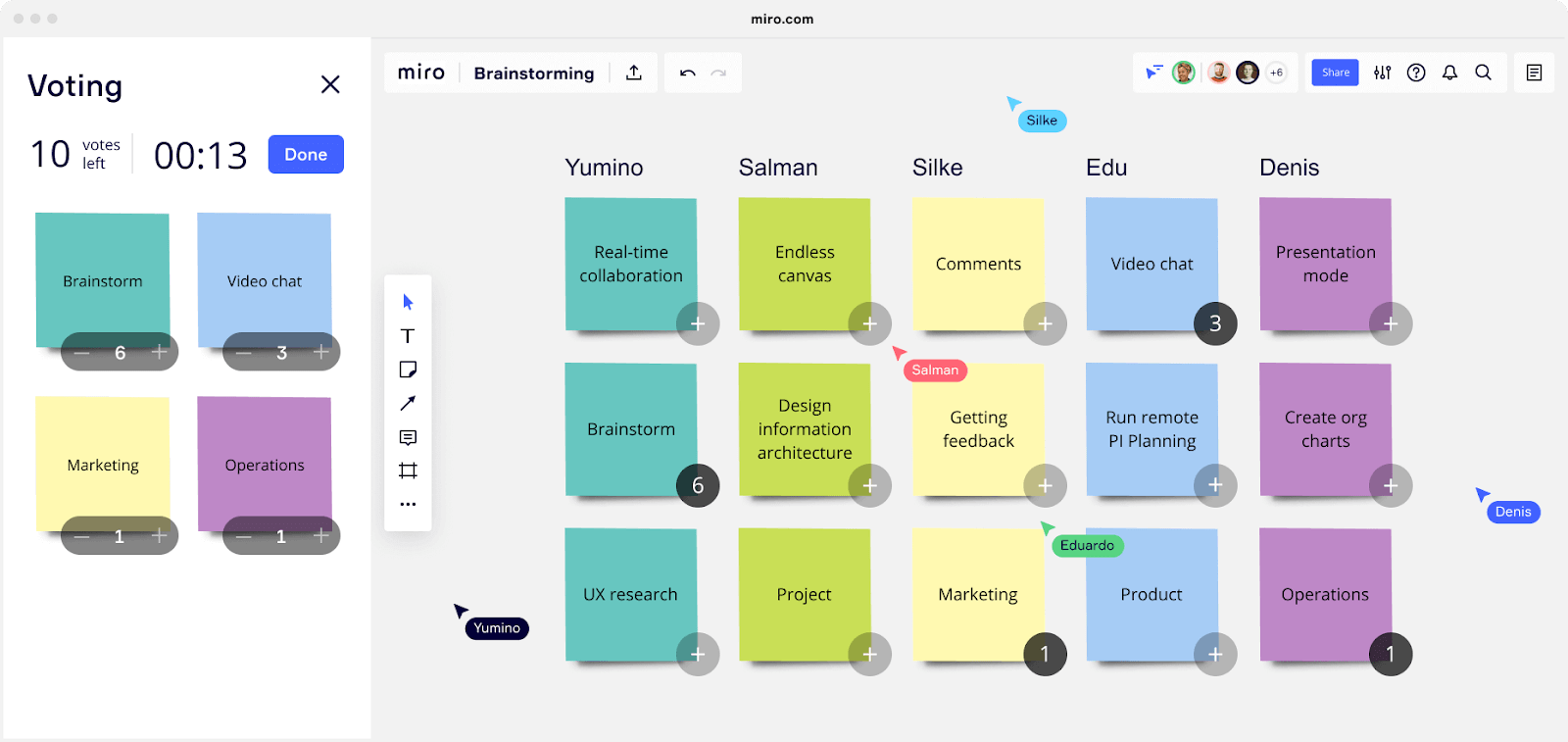
Step 7: Review and update
Once your SWOT analysis is complete, agree on time frames in which you review the data. This will form a schedule of planned reviews, but you may also choose to conduct a SWOT analysis whenever you face a significant change.
Give board access to everyone on your team so they can also consult and edit your SWOT template at any time, helping to keep it updated.
Team members can also share recent market information, add new strengths, weaknesses, opportunities, and threats, and flag factors that need to be addressed.
A SWOT analysis is key to exploiting opportunities
A robust SWOT analysis highlights everything you need to know about your strengths, weaknesses, opportunities, and threats. The data you collect means you have everything you need to make informed decisions and position your company for success.
By following the seven steps, you control where you want to go and how you get there. You can capture all your data in our SWOT analysis template using our online interactive whiteboard interface.
Discover additional SWOT analysis template examples to help you innovate faster!



